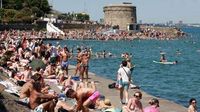As the summer of 2025 fades into early autumn, the effects of record-breaking heat continue to reverberate across Europe. From the ancient streets of Lyon to the green fields of Ireland, this was a season defined by extremes—soaring temperatures, restless nights, and communities scrambling to adapt. The stories from both France and Ireland reveal a continent grappling with the immediate impacts of climate change and the creative responses that are emerging in its wake.
In Lyon, France’s second-largest city, residents and visitors alike found themselves facing relentless heat. According to France Today, temperatures regularly edged close to, or even topped, 40°C throughout the summer and into early fall. The situation reached a critical point on August 11, 2025, when a red heatwave alert was declared following a string of stifling nights and record highs across the Rhône region. The city, already renowned for its vibrant cultural life, responded in a novel way: by opening the doors of its major museums for free as part of its “Objectif fraîcheur” (Objective Cool) policy.
This initiative offered free entry to the Musée des Beaux-Arts, Musée Gadagne, Musée d’Art Contemporain, and the Musée Lugdunum. The selection of these museums was no accident—they’re not only among Lyon’s top tourism destinations, but they also boast efficient air conditioning, making them ideal refuges from the sweltering heat. The Musée Gadagne, nestled in the picturesque Vieux Lyon district, houses both the city’s history museum and the World Puppet Museum, while the Musée des Beaux-Arts opens onto the monumental Place des Terreaux, easily accessible by public transport. The Musée Lugdunum, perched next to Lyon’s ancient Roman monuments, was also set to join the list of cool sanctuaries.
But the city didn’t stop at museums. Late openings for shadier public parks gave residents more options to escape the afternoon sun. Select shops and outlets provided free water bottle refills, and public swimming pools and water parks extended their hours into the evening. Lyon even distributed maps highlighting the best places to keep cool—a thoughtful gesture as global warming pushes summer temperatures ever higher. As France Today noted, “Aside from free access to their collections, both the Musée Gadagne and the Musée des Beaux-Arts have attractive options for keeping cool—accessible for free at any time.” The shady courtyard and open-air café balcony at the Musée des Beaux-Arts, and the historic roof garden with free deckchairs at Musée Gadagne, became havens for those seeking relief.
The city’s response stands as a model of how local governments can adapt to extreme weather while fostering community and culture. It’s a reminder that in times of crisis, the arts can offer not just inspiration, but literal shelter from the storm—or in this case, the heat.
Meanwhile, hundreds of kilometers to the northwest, Ireland was experiencing its own historic summer. On September 3, 2025, Met Éireann—the Irish Meteorological Service—provisionally declared the summer of 2025 the warmest on record for the country, with an average temperature of 16.19°C. This figure surpassed the previous record, set in 1995, by a mere 0.08°C, but the significance was clear: Ireland is warming, and the pace is accelerating.
According to Met Éireann, “Provisional Met Éireann data shows that summer 2025 is the warmest on record since 1900, when this temperature dataset began.” The summer was 1.94°C above Ireland’s long-term average, and it followed the warmest spring on record, making 2025 the first year since 1933 with back-to-back seasonal records. The persistent warmth was driven by a constellation of factors: dry soils left over from a sunny spring, heat domes over mainland Europe, and unusually high sea surface temperatures around the Irish coast. All of these contributed to consistently elevated temperatures, especially at night. As climatologist Paul Moore explained, “It hasn’t been particularly sunny during summer, but the dry soils from a warm and sunny spring, the heat domes over mainland Europe, periods of high-pressure dominance and the high sea surface temperatures around Ireland, have kept temperatures over the last three months consistently above average, especially at nighttime.”
While Ireland’s summer didn’t feature the prolonged, blistering heatwaves seen elsewhere in Europe, it was marked by a remarkable consistency. The highest temperature recorded was 31.1°C at Mount Dillon on July 12, 2025, but what pushed the record over the top was the elevated minimum temperatures throughout June, July, and August. Each of these months ranked among the top ten warmest on record—June was fourth, July was ninth, and August was fourth again. Most weather stations logged their highest mean minimum temperature for summer, and several saw the greatest number of warm nights ever recorded.
Rainfall was slightly below average—just 2% drier than usual—with notable regional variation. The west and east of the country experienced above-average rainfall, while the south and midlands were drier. The highest daily rainfall was 55.4 mm at Dunsany, Co Meath on July 21, 2025. Compared to other record summers, such as 1995 and 1976 (both much drier), 2025 was closer to average, showing that heat doesn’t always come with drought.
Underlying all of this, Met Éireann pointed to climate change as a key factor. Since 1900, Ireland’s mean air temperature has risen by about 1.1°C, with a rate of 0.22°C per decade since 1961. Notably, minimum summer temperatures have increased faster than maximums. Looking ahead, projections from Met Éireann’s TRANSLATE programme indicate that mean summer temperatures are likely to surpass the 2025 record as the century progresses, especially under moderate and high emission scenarios. “Climate change has the power to turn previously unremarkable years into record-breaking ones, as baseline conditions steadily rise,” the agency observed.
The broader European context only amplifies these local stories. Heat domes over western and central Europe triggered heatwaves not just in France and Ireland, but across the continent. Marine heatwaves lingered around Ireland’s coasts, keeping nighttime temperatures elevated. And while 1995 remains legendary in Irish memory for its string of hot days and dry spells, 2025’s achievement was in its relentless, persistent warmth—an unsettling new normal shaped by the steady march of climate change.
As Lyon’s museums filled with grateful guests and Ireland’s meteorologists recalibrated their records, one thing became clear: the summer of 2025 will be remembered not just for its numbers, but for the way communities adapted, responded, and found moments of respite amid the heat. The lessons learned this year will likely shape how cities and countries across Europe prepare for the increasingly unpredictable summers to come.


